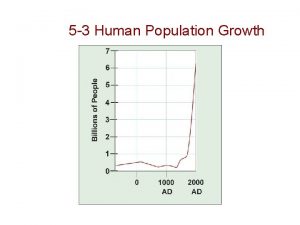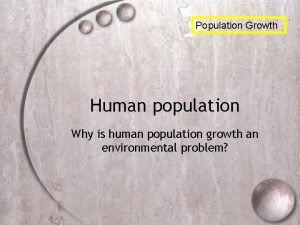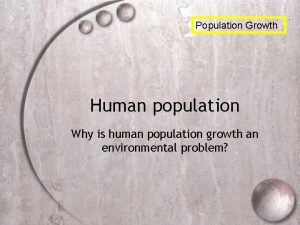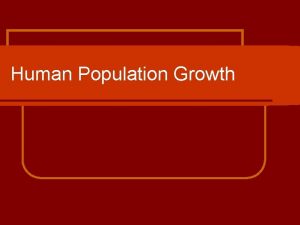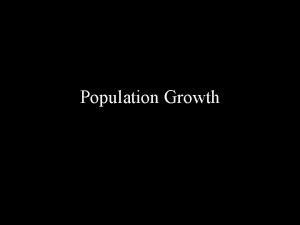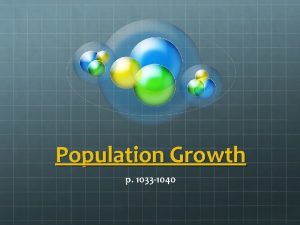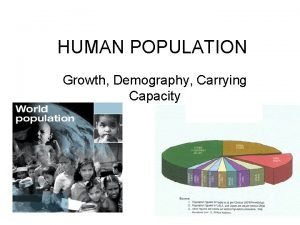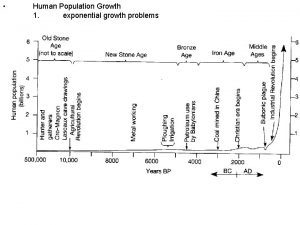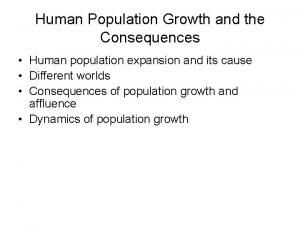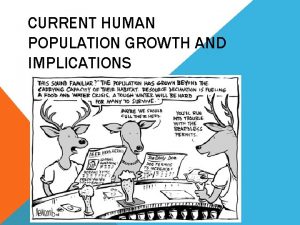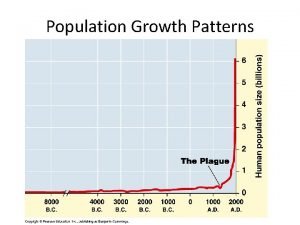DAY 106 POPULATION GROWTH HUMAN POPULATION GROWTH Year



















- Slides: 19

DAY 106 –POPULATION GROWTH

HUMAN POPULATION GROWTH Year Number of People 1650 . 50 1750 . 70 1850 1. 0 1925 2. 0 1956 2. 5 1966 3. 3 1970 3. 6 1974 3. 9 1976 4. 0 1980 4. 4 1991 5. 5 2000 6. 0 2004 6. 4 2010 6. 9 2015 7. 3 Statistics on Human Population Growth (in Billions)

INSTRUCTIONS FOR CREATING YOUR GRAPH. Place time on the horizontal access. Values should range from 1650 to 2020. Place number of people on the vertical access. Values should range from 0 to 20 billion. Make sure that your graph is a full page in size and you have the correct labels for the X and Y access and a title for your graph.

INSTRUCTIONS FOR CREATING YOUR GRAPH.

ANALYSIS 1. It took 1649 years for the world population to double, going from. 25 billion people to. 50 billion people. How long did it take for the population to double once again? 2. How long did it take for the population to double a second time? ______ A third time? _______ 3. Based on your graph, in what year will the population reach 8 billion? _______ 4. Based on your graph, how many years will it take for the population of 2004 to double? _______

ANALYSIS 1. It took 1649 years for the world population to double, going from. 25 billion people to. 50 billion people. How long did it take for the population to double once again? It doubled again between 1650 and 1850 2. How long did it take for the population to double a second time? 75 Years A third time? 1976, 51 years 3. Based on your graph, in what year will the population reach 8 billion? Answers vary, extend the curve out from the graph, possibly around 2015 4. Based on your graph, how many years will it take for the population of 2004 to double? also need to estimate, perhaps near 2050 if you extend the line to where 14 billion people would be

THE EARTH'S CARRYING CAPACITY Prior to 1950, the death rate was high, which kept the numbers of humans from increasing rapidly. In the 19 th Century, the agricultural revolution increased food production. The industrial revolution improved methods of transporting food and other good. In the 20 th Century, advances in medicine, sanitation and nutrition have decreased the death rates further. These factors combined to produce the rapid growth of the human population in the 20 th century. As with any population, humans are also limited by factors such as space, amount of food and disease. The carrying capacity is the number of individuals that a stable environment can support. Authorities disagree on the maximum number of people that the earth can support, though the numbers generally range for 8 to 10 billion.

THE EARTH'S CARRYING CAPACITY As the population approaches its limit, starvation will increase. Some countries have a much higher growth rate than others. Growth rate is the number of people born minus the number of people that die. Compare the growth rates of the following countries Most countries are trying to reduce their growth rate. Zero population growth means that as many people are being born as there are dying - to achieve zero population growth, each couple would need to have no more than two children (to replace the parents). Even if this number is achieved, the population will continue to grow because the parents will still live on for decades, as their children have children and their children have children. . . and so forth. The United States reached zero population growth in the 1980's, and yet the overall population of the US still increases.

ANALYSIS 1. What factors contributed to the world's overall population growth in the last 150 years. 2. Why does a population not level off during the same year it reaches zero population growth? 3. If the carrying capacity of the earth was 9 billion people, when would this number be reached (according to your graph)? 4. What will happen when the human population exceeds the earth's carrying capacity?

ANALYSIS 1. What factors contributed to the world's overall population growth in the last 150 years. Industrialization, health care, sanitation 2. Why does a population not level off during the same year it reaches zero population growth? Older people remain in the population, many generations can be represented. 3. If the carrying capacity of the earth was 9 billion people, when would this number be reached (according to your graph)? 2025 4. What will happen when the human population exceeds the earth's carrying capacity? death rates may increase due to starvation or disease

EXAMPLE 1: GRAPH When creating a table of values, I always suggest starung with the numbers and 2 because it is important to have different types of numbers, some negative, some positive, and zero. x -2 -1 0 1 2

By plotting the five points in the table above and connecting the poem, we get the graph shown above. Notice that as the x-values get smaller, x = — 1, — 2, etc, the graph of the function gets closer and closer to the x-axis, but never touches the x-axis. This means that there is a horizontal asymptote at the x-axis or y = O. A horizontal asymptote is a horizontal line that the graph gets closer and closer to.

EXAMPLE 2: GRAPH x -2 -1 0 1 2

By plotting the five points in the table above and connecting the points, we get the graph shown above. Notice that as the x-values get larger, x = 1, 2, etc. the graph of the function gets closer and closer to the x-axis, but never touches the x-axis. This re arts that there is a horizontal asymptote at the x-axis or y= O.

Now we can look at the similarities and differences between the graphs. Similarities • The domain for each example is ell real numbers. • The range for each examples all positive real numbers. • Both graphs pass through the point (0, 1 ) or the y-intercept in each graph is 1. • Both graphs get closer and closer to the x-axis, but do not touch the x-axis. So, each graph has a horizontal asymptote at the xaxis or y=0. Differences • In Example 1, the graph goes upwards as it goes from left to right making it an increasing function An exponential function that goes up from left to right is called “Exponential Growth" • In Example 2, the graph goes downwards as It goes from left to right making It a decreasing function. An exponential function that goes down from left to right is called “Exponential Decay"

FIND THE EQUATION OF THE EXPONENTIAL FUNCTION GIVEN ITS GRAPH

FIND THE EQUATION OF THE EXPONENTIAL FUNCTION GIVEN ITS GRAPH


Here summary of the features of the graph of an exponential function, Features of the Graph of Exponential Functions In the Form f(x) = bx or y = bx • The domain of f(x) = bx is all real numbers. • The range of f(x) = bx is all positive real numbers, f(x) > 0 or y > 0 • The graph of f(x) = bx must pass through the point. (0, 1) because any number, except zero, raised to the zero power is 1. The yintercept of the graph f(x) = bx is always 1. • The graph of f(x) = bx always has a horizontal asymptote at the x-axis (f (x)=0 or y = 0) because the graph will get closer and closer to the x-axis but never touch the x-axis. • If 0< b < 1 the graph of f(x) = bx will decrease from left to right and is called exponential decay • If b > 1 the graph of f(x) = bx increase from left to right and is called exponential growth
 Day 1 day 2 day 3 day 4
Day 1 day 2 day 3 day 4 Day 1 day 2 day 817
Day 1 day 2 day 817 Geotropism
Geotropism Whats a density dependent factor
Whats a density dependent factor Global population age distribution
Global population age distribution Year 6 leavers poem from teacher
Year 6 leavers poem from teacher The population of smallville in the year 1890 was 6250
The population of smallville in the year 1890 was 6250 The population of smallville in the year 1890 was 6250
The population of smallville in the year 1890 was 6250 New year's day
New year's day We've waited all through the year
We've waited all through the year Which of the following instruments measures air pressure?
Which of the following instruments measures air pressure? 106 spelled out
106 spelled out Fahrenheit 451 pages 45-65 summary
Fahrenheit 451 pages 45-65 summary Cs 106 a
Cs 106 a Zodiac telemetry
Zodiac telemetry Mae 106
Mae 106 Plt 106
Plt 106 106 pal
106 pal 106 signal brigade
106 signal brigade Error n 106
Error n 106




